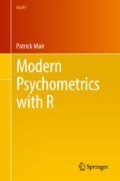Abstract
This chapter introduces network approaches to analyze associations in multivariate datasets. The first part of this chapter deals with classical (social) network analysis with relational input data. In psychological applications, however, it is rather uncommon to directly observe relational data. Therefore, a main focus in the remainder of this chapter is on networks based on a correlation input matrix. After introducing basic correlation networks, they are extended to partial correlation networks including the graphical lasso, which removes edges using regularization. The following section illustrates how scaling approaches can be integrated into networks. This leads to eigenmodels, which in a subsequent step are extended toward the incorporation of clustering (latent class networks). The final section is about Bayesian networks, a method based on the graph-theoretic concept of directed acyclic graphs. Bayesian networks do not involve correlations and allow researchers to study directed relationships among variables.
Access this chapter
Tax calculation will be finalised at checkout
Purchases are for personal use only
Notes
- 1.
This is of course a bit of an oversimplification; more details on graph layouts such as Fruchterman-Reingold and Kamada-Kawai can be found in Kolaczyk and Csárdi (2014).
- 2.
For running time purposes we keep the burn-in and the number of iterations low. In practice they should be higher.
- 3.
To be more precise, their radius is equal to the square root of the posterior intra-cluster variance estimates.
- 4.
The reader is encouraged to refit the model multiple times (of course, without setting a random number seed), and it will be obvious that the graph changes from fit to fit.
References
Borsboom, D., & Cramer, A. O. J. (2013). Network analysis: An integrative approach to the structure of psychopathology. Annual Review of Clinical Psychology, 9, 91–121.
Butts, C. (2008). network: A package for managing relational data in R. Journal of Statistical Software, 24(2), 1–36. http://www.jstatsoft.org/v24/i02/paper
Csárdi, G., & Nepusz, T. (2006). The igraph software package for complex network research. InterJournal Complex Systems, 1695. http://igraph.org/
Epskamp, S., Cramer, A. O. J., Waldorp, L. J., Schmittmann, V. D., & Borsboom, D. (2012). qgraph: Network visualizations of relationships in psychometric data. Journal of Statistical Software, 48(4), 1–18. http://www.jstatsoft.org/v48/i04/
Friedman, J., Hastie, T., & Tibshirani, R. (2008). Sparse inverse covariance estimation with the graphical lasso. Biostatistics, 9, 432–441.
Friedman, J., Hastie, T., & Tibshirani, R. (2014). glasso: Graphical lasso estimation of Gaussian graphical models. R package version 1.8. https://CRAN.R-project.org/package=glasso
Hoff, P. D. (2008). Modeling homophily and stochastic equivalence in symmetric relational data. In J. C. Platt, D. Koller, Y. Singer, & S. Roweis (Eds.) Advances in neural information processing systems 20 (pp. 657–664). Cambridge: MIT Press.
Hoff, P. (2012). eigenmodel: Semiparametric factor and regression models for symmetric relational data. R package version 1.01. https://CRAN.R-project.org/package=eigenmodel
Hoff, P. D., Raftery, A. E., & Handcock, M. S. (2002). Latent space approaches to social network analysis. Journal of the American Statistical Association, 97, 1090–1098.
Højsgaard, S., Edwards, D., & Lauritzen, S. (2012). Graphical models with R. New York: Springer.
James, G., Witten, D., Hastie, T., & Tibshirani, R. (2013). An introduction to statistical learning with applications in R. New York: Springer.
Kolaczyk, E. D., & Csárdi, G. (2014). Statistical analysis of network data with R. New York: Springer.
Krivitsky, P. N., & Handcock, M. S. (2008). Fitting position latent cluster models for social networks with latentnet. Journal of Statistical Software, 24(5), 1–23. https://www.jstatsoft.org/article/view/v024i05
McNally, R. J., Mair, P., Mugno, B. L., & Riemann, B. C. (2017). Comorbid obsessive-compulsive disorder and depression: A Bayesian network approach. Psychological Medicine, 47, 1204–1214.
Pearl, J. (2009). Causality. New York: Cambridge University Press.
Sachs, K., Perez, O., Pe’er, D., Lauffenburger, D. A., & Nolan, G. P. (2005). Causal protein-signaling networks derived from multiparameter single-cell data. Science, 308, 523–529.
Scutari, M. (2010). Learning Bayesian networks with the bnlearn R package. Journal of Statistical Software, 35, 1–22. http://www.jstatsoft.org/v35/i03/
Scutari, M., & Denis, J. B. (2015). Bayesian networks with examples in R. Boca Raton: CRC Press.
Scutari, M., & Nagarajan, R. (2013). On identifying significant edges in graphical models of molecular networks. Artificial Intelligence in Medicine, 57, 207–217.
Wasserman, S., & Faust, K. (1994). Social network analysis: Methods and applications. Cambridge: Cambridge University Press.
Author information
Authors and Affiliations
Rights and permissions
Copyright information
© 2018 Springer International Publishing AG, part of Springer Nature
About this chapter
Cite this chapter
Mair, P. (2018). Networks. In: Modern Psychometrics with R. Use R!. Springer, Cham. https://doi.org/10.1007/978-3-319-93177-7_11
Download citation
DOI: https://doi.org/10.1007/978-3-319-93177-7_11
Published:
Publisher Name: Springer, Cham
Print ISBN: 978-3-319-93175-3
Online ISBN: 978-3-319-93177-7
eBook Packages: Mathematics and StatisticsMathematics and Statistics (R0)

